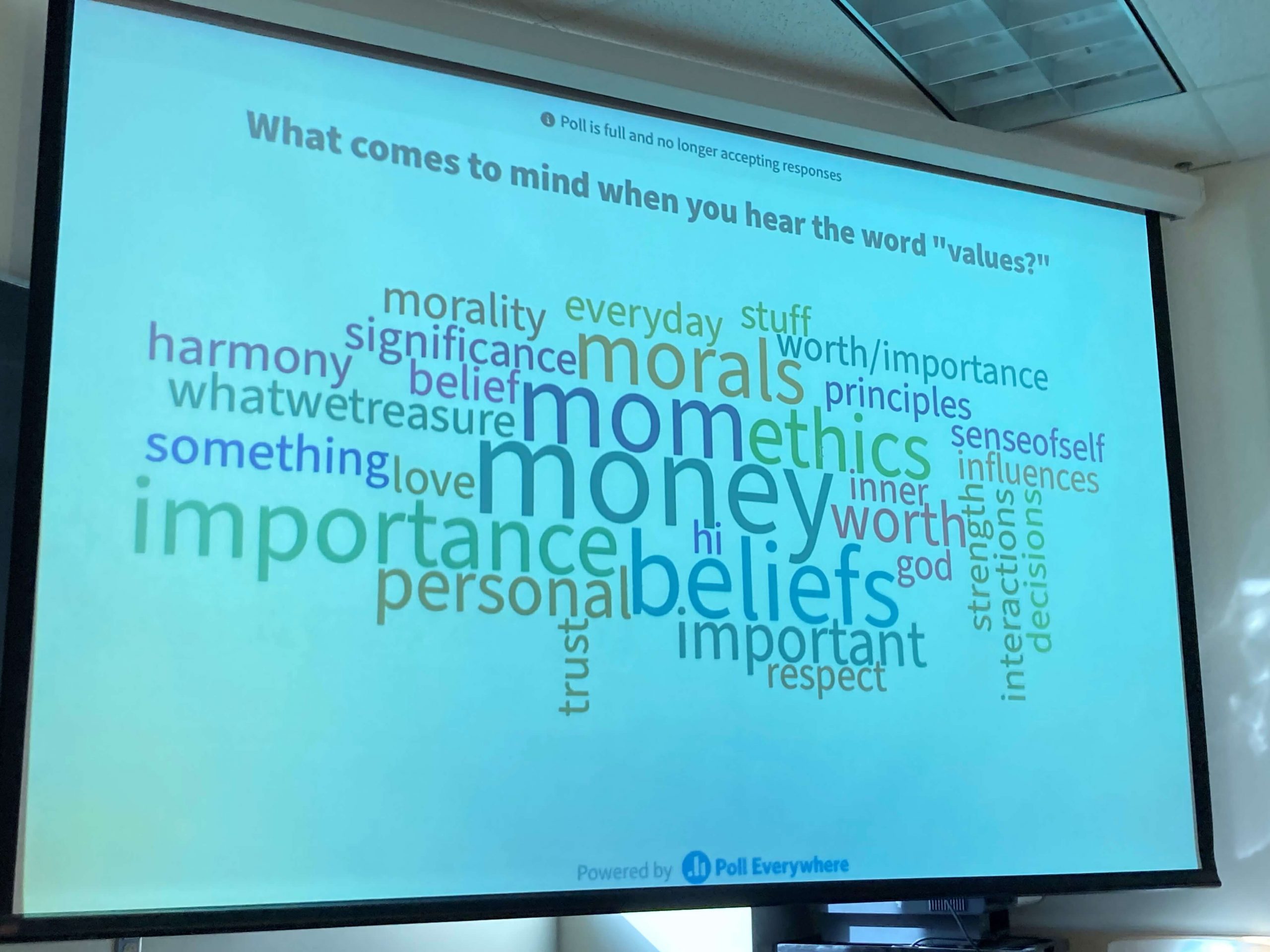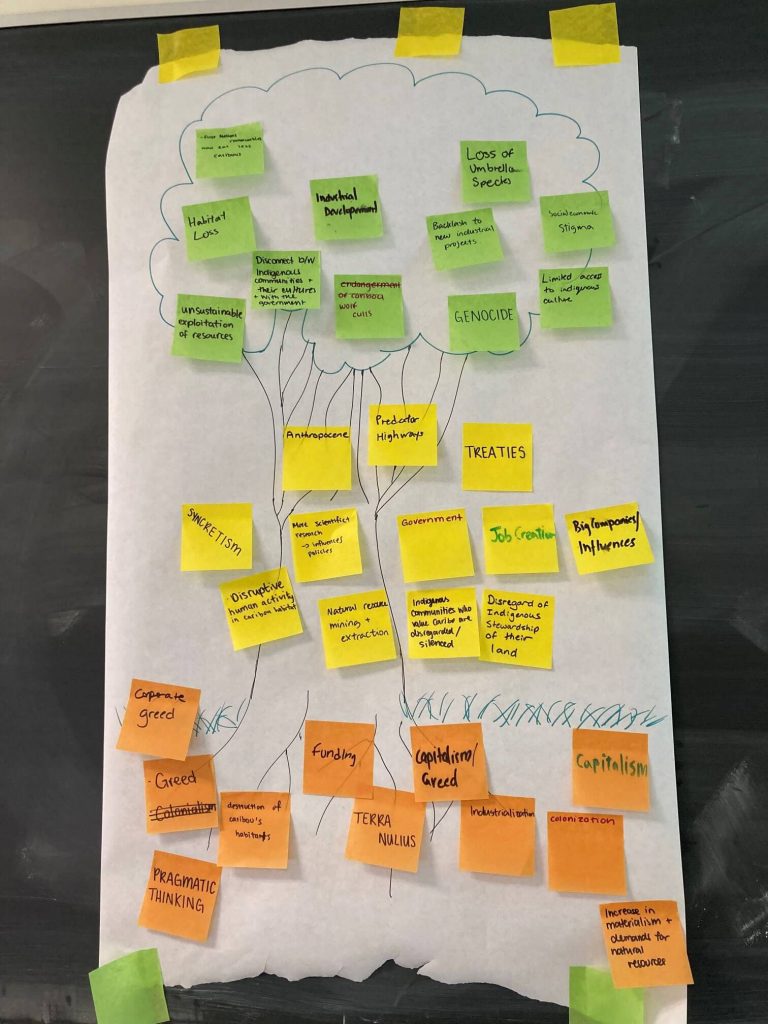
This past term Ilke Geladi and Blaire Steinwand tried something new in their section of BIOL 180: They incorporated two new classroom activities to help students explore systems thinking and identify their own personal values in preparation for their final projects.
Below, Ilke and Blaire share their motivation for doing this, how they did it, the impact it had on students and the course, and what they learned along the way.
What was your motivation for including these lessons in your course? What were you trying to achieve?
One of our goals with the final project in BIOL 180 is to give students autonomy and ownership over what they are doing so that they get excited about it and are motivated to communicate what they are learning. Within the themed topic of their section, what do they want to learn more about? In the past we’ve provided an open-ended space for them to explore this, but this time we wanted to provide more scaffolding for this process, so we integrated two activities in one of the class sessions to give them more guidance and structure in reflecting together and brainstorming about what they wanted to do with their final project.
What did you do?
Before having students decide what they were going to do for their final project, we facilitated a class session that included a systems thinking exercise followed by a values activity. We began the lesson with the InequaliTREE exercise, where students worked in their project groups to draw a tree on a large piece of poster paper and then identify different parts of the system associated with the course topic. The leaves represented the biological and societal issues that we can see, the trunk represented what leads to those issues, and the roots represented the root causes of the issue. After they had built a tree in their group, we had each group present their tree to the class and then we took all the different ideas and made a ‘mother tree’ together. This activity was fun because after thinking and talking about our course topic all term, the students had the opportunity to synthesize everything and see the bigger picture of what they were learning.

After constructing the trees, we moved into the Root Values exercise where we asked students to individually consider the ‘forest’ that we had just created with the trees and to articulate a story that they wanted to tell about it. They were then asked ‘why do you care about telling this story?’ After they had written down their answer, the next prompt was ‘why do you care about that?’, followed by this same question, followed by the same question again, and so on until their answer reflected an underlying value. We helped push them to keep challenging themselves and to go as far as they could until their reached their root value. This individual values exercise gave them the opportunity to reflect on their own and to really pinpoint a value of theirs that was important to them and to what they wanted to communicate through their project.
What was the result?
Pairing the values exercise with the systems thinking tree exercise allowed students to bring in their own unique perspectives and stories based on their lived experiences and personal identities, and to share them with each other to build and construct knowledge together as a larger group.
First, the tree exercise helped them get out of the weeds and see the bigger picture so that they could situate the topic within a larger societal context. This motivated them to think a bit differently, especially because systems thinking probably isn’t something they have done a lot before coming to first-year university.
Students were then able to connect their understanding of the system to their values, which allowed the final projects to take on an aspect of personal discovery for students. Some common values that came out of the root values exercise were empathy, love, respect, and truth, and it was really beautiful to see these values intentionally reflected in their final projects. It also made the projects more meaningful and personal to the students.
What impact did it have on students or the course?
We found that students settled on a final project topic a lot faster and were more excited about it than in previous terms. It usually takes them at least two classes to even decide on what they’re going to do, and then it changes a lot as they’re working on it, but this time they were able to quickly settle on something that they were excited about and then made it work.
Also, when they were creating the trees, it was interesting to see groups think about things in different ways and then share their perspectives with each other. For example, one group had put something as a leaf, while another group had put it as a root. This helped them learn that there isn’t necessarily one right answer and there can be different ways of thinking about something based on the angle you’re approaching it from.
How did students respond?
It was cool to see how the students engaged with the activities in different ways. Some students stayed a bit more abstract, while others really delved into the personal connections they had with the topic, such as something that had happened in their own lives or to a friend or family member. But regardless of what approach they took, students still got to where they need to go.
Students were also able to connect with one another in deeper ways. They had been developing their relationships with each other for the first half of the course, but this exercise really took their relationships to the next level. Sharing something so deep and personal, like that your core value is love, is different than sharing that you like to ski on the weekends. It’s another level of building relationships with others, which is especially important in first-year as students are in the process of making friendships and connections with their peers.
What did you learn or find surprising?
Students displayed a level of creativity in the final projects that we haven’t really seen before. In previous terms, most students would do infographics because it’s the easiest thing to do, but this term there was more variety in how they chose to present their work, such as through podcasts, letters/presentations to a school board, and storybooks.
Also, it was surprising how many groups took their final project in the direction of Indigenous-led conservation, and we think that a lot of this had to do with the InequaliTREE and root values exercises because this theme came up quite a bit during these activities and the students then took it and ran with it for their projects. So just by accident, we feel like these activities helped to indigenize the course and curriculum.
What advice would you give someone who wanted to do something similar in their course?
Something we did that we found helpful was piloting these activities with each other before bringing them into the classroom. This allowed us to think through how the activities would work in the classroom and how we wanted to roll them out and present them to students in a scaffolded way. It also helped us to provide more clear instructions and we were able to use what we came up with in our pilot as examples to show students when we were describing what we wanted them to do.
For the Roots Values exercise, we did have to go around and challenge certain students to really keep going to get to their personal core value because some of them stopped too soon or had trouble going further. Helping them to either rephrase their sentence or just pushing them to respond to a few more ‘why do you care about that?’ prompts was something we did to help them get to their root value. In a larger class, you could have students challenge each other if you don’t have time to go around to each student.
Is there anything else you would like to share?
It is always risky to try something new in your course, especially in this case because we were using activities that are more commonly found in the social sciences and not really in biology courses. But it turned out really well! The students enjoyed it, and they actually did better with the InequaliTREE activity than we did when we piloted it together! We encourage you to try out new things and take risks in the classroom. Every once while something might flop, but in our experience, it almost always pays off, and this was definitely the case with these activities.